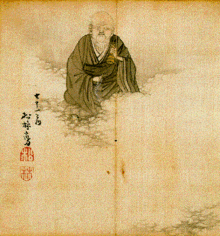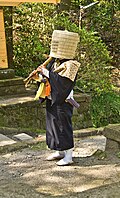Puhua | |
|---|---|
Zhenzhou Pǔhuà (鎮州普化) | |
 A depiction of the folkloric Puhua (Fuke in Japanese) in the clouds, ringing his hand-bell with a clapper (called to in Chinese, taku in Japanese). | |
| Personal | |
| Born | 770 |
| Died | Ambiguous (840 or 860) – {see below} China (Tang dynasty) |
| Religion | Buddhism |
| Nationality | Tang Chinese |
| School | Mahāyāna |
| Lineage | Chán (Zen) |
| Sect | Linji (Rinzai) |
| Monastic name | P'u Hua Chán Shih (Fuke-Zenji) |
| Profession | Mendicant, Zen master, religious leader |
| Military service | |
| Rank | 1st 'Patriarch' of Fuke Zen |
| Senior posting | |
| Teacher | Panshan Baoji, Linji Yixuan |
| Predecessor | Panshan Baoji |
| Successor | Debatable/Ambiguous: Ennin and/or Zhang Bai and/or Chang Po (Chōhaku) |
Students
| |
| Profession | Mendicant, Zen master, religious leader |
| Part of a series on |
| Komusō |
|---|
 |
| People |
|
| Philosophy |
| Places |
|
| Topics |
| Literature |
|
| Part of a series on |
| Zen Buddhism |
|---|
 |
| Part of a series on |
| Chinese Buddhism |
|---|
 |
Zhenzhou Puhua (Chinese: traditional: 鎮州普化, simplified: 普化, pinyin: Zhenzhou Pǔhuà; Japanese: Jinshu Fuke, honorifically Fuke Zenji (lit. "Zen master Fuke")—allegedly ca. 770–840 or 860),[1][2] also called P'u-k'o, and best known by his Japanese name, Fuke, was a Chinese Chán (Zen) master, monk-priest, wanderer and eccentric, mentioned in the Record of Linji (J. Rinzai-roku 臨剤録). Fuke was used to create a legend for the komusō samurai-monks that appeared in Edo-period Japan. They used their self-named Fuke Zen to establish a constructed connection to Japanese Rinzai Zen Buddhism in the 17th or 18th century. The legend is written in the Kyotaku Denki (虚鐸伝記), first published in 1795 together with a "Japanese Translation" of the "original" in literary Chinese (kanbun). The original text may have been written in the middle of the 17th century, but there are no historic texts to support this. For the komusō (虚無僧) samurai-monks, he was considered the traditional antecedent—at least in spiritual, mythological, or philosophical terms—of their order, which was formally established in Edo Japan. It is possible that the ideological roots of the sect derived from the Rinzai poet and iconoclast Ikkyū and the monk Shinchi Kakushin (心地覺心) who traveled to and from China and Japan in the 13th century. Still, according to some accounts, the sect is simply a more direct derivative of the Rinzai school and its teachings.
The few records of Puhua's life and affairs are those accounted, if only briefly, in several East Asian religious or historical references. One of the only credible sources on his life is to be found in the Tang dynasty Record of Linji (Records of Rinzai), wherein he is portrayed as an obscure student and eventual dharma heir of Panshan Baoji, as well as a friend, colleague, student and/or contemporary of Linji Yixuan, who founded the Linji (臨済宗 Rinzai) sect in China. This implies that he may have been a real individual.
The legends surrounding Puhua were more recently mentioned in the Monumenta Nipponica, R.H. Blyth's A History of Haiku (published in 1963) as well as some of the writings of Osho, along with later publications concerning the Fuke-shū, the shakuhachi and related topics. In 1988 a shakuhachi learning and playing manual co-authored by the shakuhachi performer Christopher Yohmei Blasdel and the scholar Kamisango Yūkō was published; the work is entitled The Shakuhachi: A Manual for Learning (ISBN 978-1933606156), and thoroughly details the historicity of Fuke/Puhua and the precursors to Fuke Zen in China.
- ^ Osho Bob. "Zhenzhou Puhua – Zen Master". Zen Masters. Osho Bob's [The] Living Workshop. Retrieved 14 July 2011.
- ^ Linji Yixuan (d. 867) (2009) [Composed 1120]. Thomas Yuho Kirchner (ed.). Linji lu [The Record of Linji]. Translated by Ruth Fuller Sasaki (1975 ed.). United States: University of Hawai'i Press. p. 97. ISBN 978-0-8248-2821-9.
{{cite book}}: CS1 maint: numeric names: authors list (link)
© MMXXIII Rich X Search. We shall prevail. All rights reserved. Rich X Search
